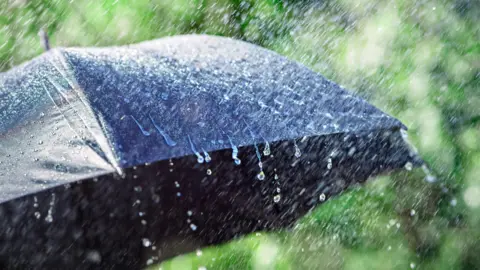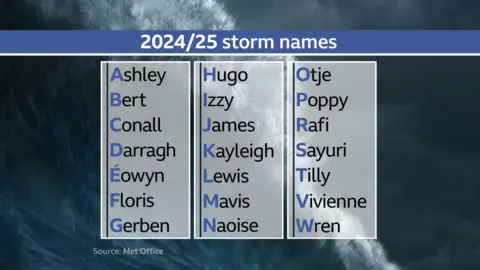 Getty Images/Brian A Jackson
Getty Images/Brian A JacksonTrain lines are closed, roads shut and a gritter has become stuck in snow as Storm Bert brings heavy rain and wind to Northern Ireland.
The railway lines between Belfast and Antrim and Newry and Portadown are closed due to flooding, according to the public transport operator Translink.
The gritter got stranded in the area of the Coleraine Mountain Road, which was closed for a period due to snow but is now described as passable with care.
Other roads have been blocked by fallen debris and motorists have been warned of difficult driving conditions.
Fallen trees
Yellow warnings for rain, wind and snow are in force for the whole of Northern Ireland until 11:00 GMT on Saturday.
Police officers have advised “extreme caution” to anyone driving in the Causeway Coast and Glens Council area where snow is continuing to cause problems.
They said a roof was reportedly blown off a shed in Dungiven, County Londonderry and is obstructing the Ballyquinn Road.
The TrafficWatchNI service is reporting “very difficult driving conditions” on some higher areas including the Glenshane Pass, Windyhill Road in Limavady and Glenpark Road, Omagh.
In addition to the snow:
- A tree and utility lines have come down onto the Belfast Road in Newtownards, partially obstructed the road
- In County Tyrone the Dergbrough Road, Plumbridge, is fully closed due to a fallen tree
- The Coast Road in Ballygally is also shut because of a rock fall, which is believed to be related to Storm Bert
- P&O Ferries cancelled Saturday’s 04:00 GMT ferry between Larne and Cairnryan but said passengers would be accommodated on the 08:00 sailing
In the Republic of Ireland, more than 30,000 homes are without power, after Storm Bert descended overnight.
Met Éireann (the Irish Meteorological Service) has issued red warnings for heavy rain in west Cork and west Galway.
It has warned this could cause severe flooding and damage to property in the affected areas, as well as difficult driving conditions.
Met Éireann’s red warnings – its highest level of alert – are in force until 10:00 local time on Saturday.
It has also issued a status orange warning for rain in counties Waterford, Kerry, Clare, Mayo, Sligo and Leitrim over the same time period.
In County Donegal a status yellow warning is in force for snow/ice, rain and strong wind until noon.
That county has been the worst hit for power cuts, with about 12,000 people without electricity, particularly in the Gweedore and Buncrana areas.
Other counties affected include Kerry, Sligo, Leitrim, Roscommon and Galway.
Why and how are storms named?

The naming of storms is a practice which helps meteorologists communicate with the public when they need to advise of dangerous or disruptive weather events.
Certain criteria have to be met before a storm is given a name.
Bert is the second named storm of the 2024/25 season which began on 1 September.
It was named by Ireland’s Met Éireann on Thursday because Irish forecasters believed it could bring severe disruption to the Republic of Ireland.
Met Éireann works in partnership with the UK Met Office and the Royal Netherlands Meteorological Institute (RNMI) every year to monitor, classify and names storms.
The three organisations agree an alphabetical list in advance of each season.
Storm Bert was preceded by disruptive snow in some parts of Northern Ireland on Friday.
Some Translink services did not run on Friday morning, including buses serving Belfast, Ballygowan, Derryboy, Omagh and Newcastle.

